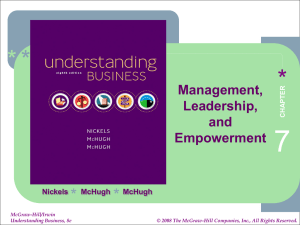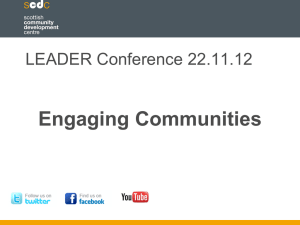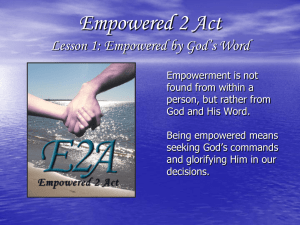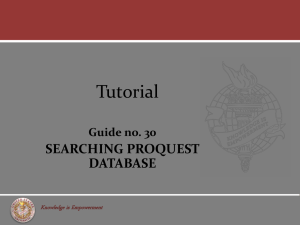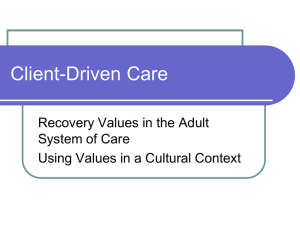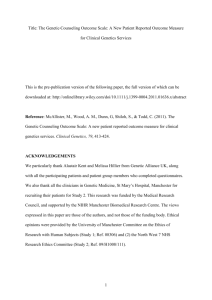System of Care - Coalition for Community Schools
advertisement
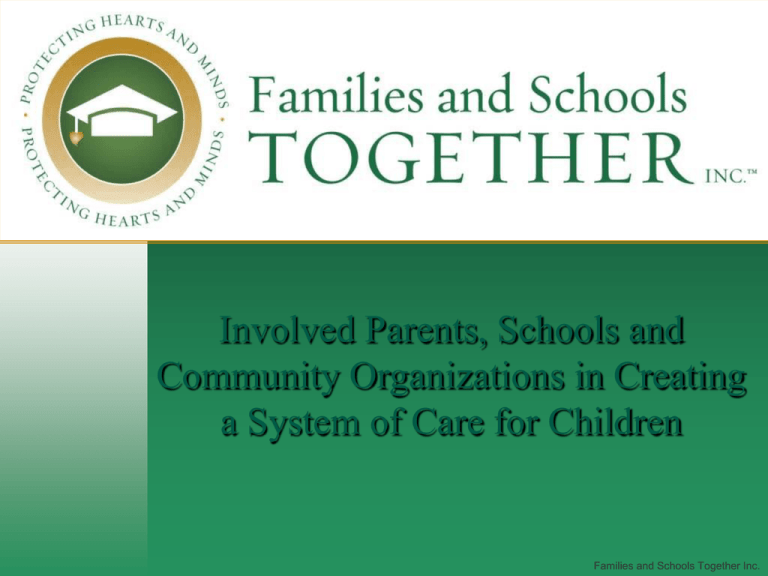
Involved Parents, Schools and Community Organizations in Creating a System of Care for Children Families and Schools Together Inc. AGENDA What is a System of Care? General Concept/Value: Parent Empowerment Overview of program Experiential How to implement the FAST program The story of LaGrange Middle School, Illinois Outcomes Families and Schools Together Inc. What is a System of Care? Families and Schools Together Inc. System of Care Families and Schools Together Inc. What is a System of Care? Systems of care is not a program — it is a philosophy of how care should be delivered. Systems of Care is an approach to services that recognizes the importance of family, school and community, and seeks to promote the full potential of every child and youth by addressing their physical, emotional, intellectual, cultural and social needs systemsofcare.samhsa.gov Families and Schools Together Inc. What is a System of Care? Systems of Care is a service delivery approach that builds partnerships to create a broad, integrated process for meeting families' multiple needs. This approach is based on the principles of interagency collaboration; individualized, strengths-based care practices; cultural competence; community-based services; and full participation of families at all levels of the system. A centralized focus of Systems of Care is building the infrastructure needed to result in positive outcomes for children, youth, and families. A system of care is a coordinated network of community-based services and supports that are organized to meet the challenges of children and youth with mental health needs and their families. Families and youth work in partnership with public and private organizations to design mental health services and supports that are effective, that build on the strengths of individuals, and that address each person's cultural and linguistic needs. A system of care helps children, youth and families function better at home, in school, in the community and throughout life. Families and Schools Together Inc. Creating a Systems of Care Need a Frame Work Need a Structure Need Training Need Defined Roles & responsabilities Families and Schools Together Inc. Exercise Systems of Care • Think, Pair, Share Exercise Think: • Think about what systems of care means. Write down one or two examples that illustrate empowerment. Pair: • Pair up with a person at your table. Share: • Share your examples and definition of systems of care with your partner. Then select a spokes person for the group who will share your thoughts and ideas with the group. Families and Schools Together Inc. What is EMPOWERMENT? Families and Schools Together Inc. Exercise Empowerment • Think, Pair, Share Exercise Think: • Think about what empowerment means. Write down one or two examples that illustrate empowerment. Share: • Share your examples and definition of empowerment with your partner. Then be prepared to share your thoughts and ideas with the group. Families and Schools Together Inc. Empowerment is the process that is essential to activate people’s capacity to satisfy their own needs, solve their own problems, and acquire the necessary resources to take control over their life. (from S. Talseth, 1997) Families and Schools Together Inc. Parents & Youth Staff Administration Families and Schools Together Inc. KEY ELEMENTS OF EMPOWERMENT Information Choices Respect/acceptance Help and support to others Families and Schools Together Inc. The Importance of Empowering Parents Empowerment is a basic need for any parent raising a child Treating parents as partners in the educational process is essential to school success Program retention Voluntary participation: free choice Recruitment: being wanted and feeling cared for Receptiveness to program messages Families and Schools Together Inc. What is Families and Schools Together (FAST)? Created by a Social Worker Prevention/Early Intervention Program Collaborative model Whole family approach Multi-family group based Empowers parents UW Madison- Research Partner Builds relationships with community-based organizations Gives youth a voice Builds youth leadership Families and Schools Together Inc. Values of FAST Parents already have power; they have the right to decide to use that power. Empowerment is not a top-down approach. Look for strengths versus deficits in working with parents and families. Parents are capable of being the primary prevention agents for their own children. Stress and social isolation diminish parental effectiveness; social support increases parental effectiveness. All parents love their children and want a better life for them. Families and Schools Together Inc. FAST Versions Baby FAST: for young mothers/fathers, their mothers, and the babies (ages 0 3) Early Childhood FAST: for parents and their children ages 3 - 5 Elementary School FAST: for parents and their children in K-5 Middle School FAST: for parents and children in 6-8th grade High School FAST (under development): for parents and their 9th graders Families and Schools Together Inc. Research Base Brain Research Social Capital Social Ecology of Child Development Social Control/Bonding Theory • Hirschi, Naroll, Kohn & Massey Family Stress & Coping Theory • Hill & McCubbin Family Systems Theory • Minuchin, Satir, Parsons & Alexander Risk & Protective Factors Research • Werner, Gramezy,Schedler & Block, Rutter, Kumpher & Hawkins Families and Schools Together Inc. Social Ecology of Youth Development Youth Families and Schools Together Inc. Social Ecology of Youth Development Youth Family Families and Schools Together Inc. Social Ecology of Child Development School Youth Family Families and Schools Together Inc. Social Ecology of Youth Development Youth School & Family Social Workers Neighborhood Community Families and Schools Together Inc. Social Ecology of Youth Development Community School Youth Family Families and Schools Together Inc. To become a successful adult, a youth needs support from at least one caring adult Families and Schools Together Inc. “A mother’s eyes are a baby’s skies.” Families and Schools Together Inc. To be tuned into a child, a father/mother needs support Families and Schools Together Inc. “Relationships are to child development what location is to real estate.” James Comer, M.D. Psychiatrist, Yale University Families and Schools Together Inc. Program Goals Enhance family functioning Prevent the focal youth from experiencing school failure Prevent substance abuse by the youth and family Reduce the stress that parents and youth experience from daily life situations Overall, to increase the likelihood of the youth being successful in the home, in middle school, and in the community. Families and Schools Together Inc. Why these goals? Families with high conflict are more likely to have youth who use alcohol Families with high cohesion and expressiveness are less likely to have depression and loneliness Children who have good impulse control will do better in school Families and Schools Together Inc. FAST Team Parent Partner School Partner Mental Health Professional Substance Abuse/AODA Professional Youth Representative Youth Advocate Volunteers Team must be ethnically representative of families being served For greater success recruiting fathers, team should include men. Families and Schools Together Inc. How Does Middle School FAST Work? 14 Weekly Youth Rap Sessions 10 Weekly Multi-Family Group Sessions Group – 14 Weekly Meetings Youth Fun, Interactive Programming Weeks 1 – 14, Led by Youth Advocate & Youth Partner Family Group – 10 Weekly Meetings Weeks 5 – 14, Led by the Whole Team Week 1 Week 5 Week 14 Families and Schools Together Inc. Family Unit at Family Table •Flag (1st night only) •Meal •FAST Hello •FAST Song Parents’ Time •Buddy Time •Parent Self-Help Group Peer Group Time YOUTH GROUP AT FAST One-to-One Time Focal Youth & Parent 10 weeks of family meetings Kids’ Time Children divided by age group for group activities Siblings continue Kids’ Time Family Table: GAME & Lotto Closing Circle Announcements & RAIN Families and Schools Together Inc. Families and Schools Together Inc. Families and Schools Together Inc. Families and Schools Together Inc. Families and Schools Together Inc. Parent’s Time Families and Schools Together Inc. Families and Schools Together Inc. Families and Schools Together Inc. Families and Schools Together Inc. Families and Schools Together Inc. Families and Schools Together Inc. FAST Special Sessions Week 5 – Violence Prevention, Gangs, Substance, etc. Week 10 – Graduation Ceremony Families and Schools Together Inc. Families and Schools Together Inc. The Story of the LaGrange School District, Illinois Recipient of the Directors Award for Excellence in Transforming and Promoting Mental Health of Young Children by SAMHSA in 2004 Families and Schools Together Inc. LaGrange Mental Health Crisis Benefits of collaborative team (different areas of expertise) Benefits of collaborating with community agencies Benefits of accessing community resources Families and Schools Together Inc. Keys To Success Collaboration across agencies, building social capital Respect for participants Programmatic fidelity: adaptation, not drift Cultural representation Families and Schools Together Inc. Evaluation Each program cycle is evaluated Parents and youth complete pre- and posttests n=1,956 youth n=1,907 parents Families and Schools Together Inc. Measures Social Relationships Questionnaire (children, other adults) Social Support (emotional, tangible, affectionate and total support) Reciprocal Support with Other Parents Parental Involvement in Education Family Environment Scale (FES)-Family Relationships Index (Completed by both Parents and Youth) Parenting Style Strength and Difficulties Questionnaire (Completed by both Parents and Youth) Youth Stress Checklist Coping Responses Checklist School Behavior Families and Schools Together Inc. Parent Respondents Average age: 39 years Race/Ethnicity 43% Caucasian/White 27% Hispanic/Latino 21% African American/Black Relationship to youth 89% mother/father 5% grandparent Marital status 53% married 16% divorced 12% never married 7% separated 7% member of unmarried couple Families and Schools Together Inc. Parent Respondents Educational attainment 21% less than high school education 31% high school diploma or GED 10% junior/vocational college 19% some college – not junior/vocational 20% college graduate and/or graduate school Employment status 51% full-time job 16% part-time job 10% unemployed, looking for work 11% not employed outside home 8% disabled, unable to work Families and Schools Together Inc. Youth Respondents Average age: 12 years Gender 48% male 52% female School behavior Suspended from school in past year: 26% Skipped school in past year: 36% Grades, mostly C’s and below: 22% Families and Schools Together Inc. Building Relationships has Results for Adults and Youth 100% After 86% FAST, percent of parents reporting… 80% 60% 51% 51% 44% 40% 27% 22% 20% 0% New Friends Adult Return to Education Work Attend Church PTO Volunteering Families and Schools Together Inc. Parenting Skills Parents rated their own levels of personal effectiveness in general, in social situations, and as parents. Selfefficacy scores showed that 51% of parents improved. Families and Schools Together Inc. Youth’s Strengths & Difficulties On the Strengths & Difficulties Questionnaire, parents reported improvements on the following: 100% 80% 60% 40% 63% 44% 49% 46% 48% 43% 33% 20% 0% Impact of Total Peer Prosocial Emotional Conduct Hyperactivity Problems Difficulties Difficulties Behaviors Symptoms Problems These findings indicate that youth behavior has improved. Families and Schools Together Inc. Social and Reciprocal Support Improved On the Social Support Questionnaire, parents reported the following improvements: 100% 100% 71% 80% 53% 60% 80% 60% 56% 57% 61% 43% 40% 40% 20% 20% 0% Emotional Total Support Total Social Support Relationships 0% Support Provided Support Received Total Reciprocal Support Families and Schools Together Inc. Parent Involvement in Education On the Parent Involvement in Education Questionnaire, parents reported the following improvements: 100% 80% 60% 52% 56% 47% 43% 40% 20% 0% Parent School Parent to School to Involvement School Contact Parent Contact Total Parent Involvement These increases in parental involvement in school are likely to result in greater academic success of FAST youth. Families and Schools Together Inc. For More Information Families And Schools Together, Inc. 2801 International Lane, Suite 212 Madison, WI 53704 (888) 629-2481 answers@familiesandschools.org www.familiesandschools.org Families and Schools Together Inc. International Headquarters address: Families and Schools Together Inc. 2801 International Lane, Suite 212 Madison, WI 53704-3151 Phone: Toll-free: Fax: 608-663-2382 888-629-2481 608-663-2336 Families and Schools Together Inc.


